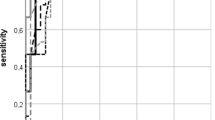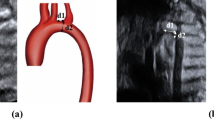Abstract
The objective of this study is to identify fetal echocardiographic measures that predict postnatal coarctation of the aorta (CoA). A retrospective review of patients from 2013 to 2017 identified 13 cases of prenatal diagnosis of CoA confirmed postnatally and 14 cases of prenatal diagnosis of CoA with normal arches postnatally. There were 30 controls. Measurements were made and indices applied on all available longitudinal fetal echocardiograms for each patient. Linear mixed effects models were used to examine the between-group differences in the trajectories of the measurements. Significant differences were seen in the true CoA group for the following: smaller distal transverse arch diameter to distance between the left common carotid and left subclavian arteries (DT/LCA–LSCA) index (p = 0.04), smaller distal transverse arch diameter (p = 0.005), and longer brachiocephalic to left common carotid artery (LCA) (p = 0.004) and LCA–left subclavian artery (LSCA) distances (p < 0.0001). Additionally, the LCA/DT index trend appears to differentiate false positives from true coarctations (p < 0.03). The fetal echocardiographic DT/LCA–LSCA index, brachiocephalic–LCA distance and LCA–LSCA distance are significant predictors of postnatal coarctation. The LCA/DT index trend over time may differentiate which of those patients with prenatal concern for coarctation are more likely to develop coarctation postnatally. The use of fetal echocardiographic measures may improve prenatal detection and predication of postnatal coarctation.


Similar content being viewed by others
References
Beattie M, Peyvandi S, Ganesan S, Moon-Grady A (2017) Toward improving the fetal diagnosis of coarctation of the aorta. Pediatr Cardiol 38(2):344–352. https://doi.org/10.1007/s00246-016-1520-6
Dodge-Khatami A, Ott S, Di Bernardo S, Berger F (2005) Carotid-subclavian artery index: new echocardiographic index to detect coarctation in neonates and infants. Ann Thorac Surg 80(5):1652–1657. https://doi.org/10.1016/j.athoracsur.2005.04.041
Franklin O, Burch M, Manning N, Sleeman K, Gould S, Archer N (2002) Prenatal diagnosis of coarctation of the aorta improves survival and reduces morbidity. Heart 87(1):67–69. https://doi.org/10.1136/heart.87.1.67
Anuwutnavin S, Satou G, Chang R-K, Devore GR, Abuel A, Sklansky M (2016) Prenatal sonographic predictors of neonatal coarctation of the aorta. J Ultrasound Med 35(11):2353–2364. https://doi.org/10.7863/ultra.15.06049
Buyens A, Gyselaers W, Coumans A et al (2012) Difficult prenatal diagnosis: fetal coarctation. Facts, Views Vis Obgyn 4(4):230–236
Sharland GK, Chan KY, Allan LD (1994) Coarctation of the aorta: difficulties in prenatal diagnosis. Br Heart J 71(1):70–75. https://doi.org/10.1136/hrt.71.1.70
Matsui H, Mellander M, Roughton M, Jicinska H, Gardiner HM (2008) Morphological and physiological predictors of fetal aortic coarctation. Circulation 118(18):1793–1801. https://doi.org/10.1161/CIRCULATIONAHA.108.787598
Soslow JH, Kavanaugh-McHugh A, Wang L et al (2013) A clinical prediction model to estimate the risk for coarctation of the aorta in the presence of a patent ductus arteriosus. J Am Soc Echocardiogr 26(12):1379–1387. https://doi.org/10.1016/j.echo.2013.08.016
Peng DM, Punn R, Maeda K, Selamet Tierney ES (2016) Diagnosing neonatal aortic coarctation in the setting of patent ductus arteriosus. Ann Thorac Surg 101(3):1005–1010. https://doi.org/10.1016/j.athoracsur.2015.09.050
Lu C-W, Wang J-K, Chang C-I et al (2006) Noninvasive diagnosis of aortic coarctation in neonates with patent ductus arteriosus. J Pediatr 148(2):217–221. https://doi.org/10.1016/j.jpeds.2005.09.036
Akhfash AA, Almsnid A, Hasson M, Alharbi B, AlGhamdi A (2012) Echocardiographic predictors of coarctation of the aorta. J Saudi Heart Assoc 24(4):273. https://doi.org/10.1016/j.jsha.2012.06.196
Familiari A, Morlando M, Khalil A et al (2017) Risk factors for coarctation of the aorta on prenatal ultrasoundclinical perspective. Circulation 135(8):772–785. https://doi.org/10.1161/CIRCULATIONAHA.116.024068
Hornberger LK, Weintraub RG, Pesonen E et al (1992) Echocardiographic study of the morphology and growth of the aortic arch in the human fetus observations related to the prenatal diagnosis of coarctation. Circulation 86:741–747. https://doi.org/10.1161/01.CIR.86.3.741
Quartermain MD, Cohen MS, Dominguez TE, Tian Z, Donaghue DD, Rychik J (2009) Left ventricle to right ventricle size discrepancy in the fetus: the presence of critical congenital heart disease can be reliably predicted. J Am Soc Echocardiogr 22(11):1296–1301. https://doi.org/10.1016/j.echo.2009.08.008
R Core Team (2018) R: a language and environment for statistical computing. R Foundation for Statistical Computing, Vienna, Austria. https://www.r-project.org/
Wickham H (2009) ggplot2: elegant graphics for data analysis. Springer, New York
Pinheiro J, Bates D, DebRoy S, Sarkar D, RCT (2018) nlme: linear and nonlinear mixed effects models. R package version 3.1-131.1. https://cran.r-project.org/package=nlme
Fox J (2003) Effect displays in R for generalised linear models. J Stat Softw 8(15):1–27
Gómez-Montes E, Herraiz I, Gómez-Arriaga PI, Escribano D, Mendoza A, Galindo A (2014) Gestational age-specific scoring systems for the prediction of coarctation of the aorta. Prenat Diagn 34(12):1198–1206. https://doi.org/10.1002/pd.4452
Allan LD, Chita SK, Anderson RH, Fagg N, Crawford DC, Tynan MJ (1988) Coarctation of the aorta in prenatal life: an echocardiographic, anatomical, and functional study. Br Heart J 59(3):356–360. https://doi.org/10.1136/hrt.59.3.356
Hornberger LK, Sahn D, Kleinman CS, Copel J, Silverman NH (1994) Antenatal diagnosis of coarctation of the aorta: a multicenter experience. J am Coll Cardiol 23(February):417–423
Mivelaz Y, Di Bernardo S, Meijboom EJ, Sekarski N (2008) Validation of two echocardiographic indexes to improve the diagnosis of complex coarctations. Eur J Cardio-thoracic Surg 34(5):1051–1056. https://doi.org/10.1016/j.ejcts.2008.07.036
Morrow WR, Huhta JC, Murphy DJ, McNamara DG (1986) Quantitative morphology of the aortic arch in neonatal coarctation. J Am Coll Cardiol 8(3):616–620. https://doi.org/10.1016/S0735-1097(86)80191-7
Acknowledgements
This publication was made possible by CTSA Grant Number UL1 RR024139 from the National Center for Research Resources (NCRR) and the National Center for Advancing Translational Science (NCATS), components of the National Institutes of Health (NIH), and NIH roadmap for Medical Research. Its contents are solely the responsibility of the authors and do not necessarily represent the official view of NIH.
Author information
Authors and Affiliations
Corresponding author
Ethics declarations
Conflict of interest
All authors declare no conflict of interest.
Ethical Approval
This article does not contain any studies with human participants or animals performed by any of the authors.
Informed Consent
This study was a retrospective review of imaging studies previously completed. Informed consent was not necessary as deemed by our institutional review board.
Appendix
Rights and permissions
About this article
Cite this article
Patel, C., Weeks, B., Copel, J. et al. Fetal Echocardiographic Measures to Improve the Prenatal Diagnosis of Coarctation of the Aorta. Pediatr Cardiol (2018). https://doi.org/10.1007/s00246-018-2040-3
Received:
Accepted:
Published:
DOI: https://doi.org/10.1007/s00246-018-2040-3




